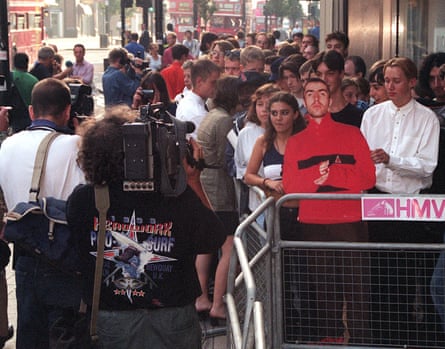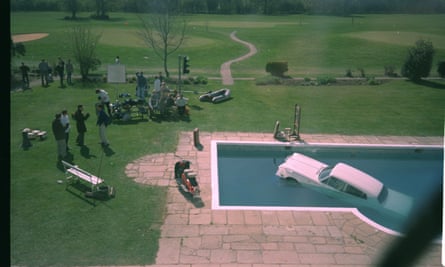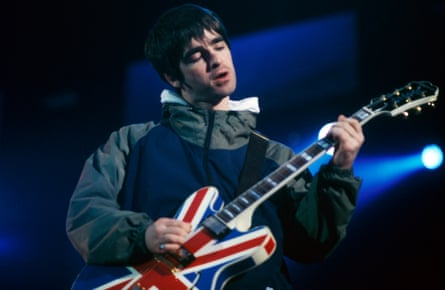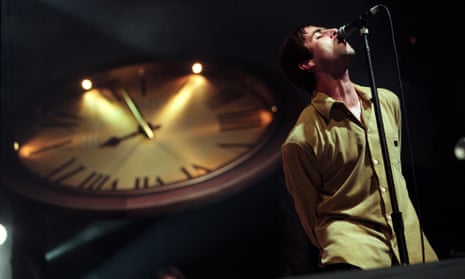On the evening of 20 August 1997, BBC1 broadcast Right Here Right Now, a panegyric to Oasis on the eve of their third album, Be Here Now. Hyperbole abounded. “I think it’s the best thing we’ve done,” said guitarist Paul “Bonehead” Arthurs. Oasis were “the most important rock’n’roll band in the world,” claimed Liam Gallagher. “We still want to eclipse every single musician in this country,” said Noel Gallagher. “Because we want to. Because we can. Because we’re the best.”
For a little while, Be Here Now demanded superlatives. With more than 696,000 copies leaving the shops in its first week, it became Britain’s fastest-selling album ever, until Adele released 25, 18 years later. Its path was paved with five-star reviews, like petals thrown beneath a Roman emperor’s feet. Footage of excited fans clutching copies made News at Ten, leading anchorman Trevor McDonald to intone the phrase “mad for it”. On the BBC news, a very young Peter Doherty, queueing to buy his copy, cited Umberto Eco in his analysis of the group.

No album in history has experienced such a swift and dramatic reversal of fortune. Be Here Now was reframed first as a disappointment and then as a disaster. It burned out quickly, falling well short of the sales achieved by 1995’s (What’s the Story) Morning Glory, with many copies ended up in secondhand racks. Noel himself quickly disowned it, dismissing it in the 2003 Britpop documentary Live Forever as “the sound of five men in the studio, on coke, not giving a fuck”. (Only Liam remained loyal: “At that time we thought it was fucking great. And I still think it’s great.”)
As Be Here Now returns in the form of a deluxe box set, and the band’s story is retold in the documentary Oasis: Supersonic, the album still inspires extreme reactions. If it couldn’t be Britpop’s zenith, then it must be the nadir. It can’t be just a collection of songs – some good, some bad, most too long, all insanely overproduced – but an emblem of the hubris before the fall, like a dictator’s statue pulled to the ground by a vengeful mob. The glowing reviews have become an opportunity for schadenfreude: evidence that music critics had, at best, lost all perspective and, at worst, deliberately misled their readers. “Right here and right now, this is the place to be,” trumpeted the Daily Telegraph. Mojo’s reviewer was even moved to patois: “This is Oasis’s World Domination Album. Dem a come fe mess up de area, seeeeeeeeerious.” In hindsight, the hysteria resembles a mass frenzy. “It’s almost like Big Brother,” says Alex Niven, author of a book about Oasis’s 1994 debut Definitely Maybe. “You were watching something crass and horrible but it was compelling and you had to watch it to get a sense of what Britain was like at that moment. It was like a performance of the collective psyche.”
I asked four of the critics who praised it – Paul Du Noyer (Q), Roy Wilkinson (Select), Paul Lester (Uncut) and Taylor Parkes (Melody Maker) – what happened and whether something like it could happen again. The starting point in revisiting the album is the acceptance that in 1997, Oasis were woven into Britain’s cultural fabric like no other band since the Beatles. Definitely Maybe permanently moved the goalposts for alternative rock in general and Creation Records in particular. (What’s the Story) Morning Glory was simply unavoidable. Wilkinson remembers hearing a pub full of pensioners sing along to Wonderwall when it came on the jukebox. “It seemed like an everyperson record,” he says. “There was a universality.” As Lester wrote in his review: “Much of the pleasure with Oasis is bound up in the shared historical moment … Like those other mid-90s newcomers, Friends, the internet, Spice Girls and the lottery, Oasis have managed to infiltrate British life in record time.”
“There are good populisms and bad populisms,” Niven says. “In the mid-90s, there was a sense that you might just have a good populism, and Oasis seemed to embody that. It nodded at sport and working-class culture and the heritage of the counterculture. Obviously, it wasn’t substantial enough so it didn’t realise its potential, but there is something valuable in that idea. I’m not sure we’ve had a collective moment on that level since. You can only get those moments when there’s a hovering suggestion of a genuine democratic breakthrough, as there was in the 60s and the mid-90s.”
Oasis’s everyman sensibility couldn’t survive the sudden flood of money and fame, unprecedented for a band from the independent scene. Noel’s new milieu of mega-gigs, celebrity parties, tabloid ubiquity and champagne at No 10 did his muse no favours. Oasis’s earlier songs had an exhilarating underdog hunger, but Be Here Now was mostly written and demoed at Mick Jagger’s villa in Mustique with a vast new audience in mind. “You start off writing songs that you’re not sure who’s going to hear them,” Noel told author Daniel Rachel. “Then, when I tried to write the next batch of songs, you’re like: ‘We’ve got 20 million fans in the world.’”
The box set reveals an intriguing vulnerability in the demos. Stand By Me has the weary tenderness of Half the World Away, and Noel’s jaundiced acoustic version of the Beatles’ Help! sounds like a cri de coeur: “And now my life has changed in oh so many ways.” That quality was flattened in the studio by the cocaine panzers, as songs were elongated and smothered in up to 30 layers of guitars. Repentant producer Owen Morris later summed it up thus: “Massive amounts of drugs. Big fights. Bad vibes. Shit recordings.” He called the final mix – a bludgeoning, airless wall of noise – “an utter disgrace”.

Before this self-conscious gigantism bedazzled critics, it bedazzled Noel and Morris. All Around the World was a white elephant based on a catastrophic misunderstanding of Hey Jude and the comeback single D’You Know What I Mean? was more rally than song. “It was massively, nuttily assertive: listen to me!” says Wilkinson. “But what was it saying? Nothing. It’s a blank space. A void.” Tim Abbot, then the marketing director at Creation, used an analogy from visual art: “They came down as little matchstick men and became a Koons.”
Noel’s pre-release interviews struck an oddly ambivalent note (“This record ain’t going to surprise many people,” he told NME), but there was nobody to echo his reservations. “Everyone’s going: ‘It’s brilliant!’” he later said. “And right towards the end, we’re doing the mixing and I’m thinking to myself: ‘Hmmm, I don’t know about this now.’” According to Oasis’s former press officer, Johnny Hopkins: “There were more hangers-on, constantly telling them they were the greatest thing. That tended to block out the critical voices.” For anyone invested in Oasis’s continued success, Be Here Now was too big to fail.
Alan McGee, Creation’s pathologically ebullient founder, told the press it was “absolute genius” and would sell 20m. But Oasis’s management firm, Ignition, was keen to manage the hype while thwarting the new threat of internet leaks, leading to neurotic secrecy. Hopkins first heard Be Here Now, alongside other key personnel, at Noel’s north London home, Supernova Heights. “We were sat around his dining table,” he remembers. “It felt a bit like a board meeting. There was a massive weight of expectation so it was really hard to hear it as a record in its own right.”
Ignition waged war with radio DJs and fan websites and required anyone handling advance copies to sign a non-disclosure agreement that barred them from even discussing it with anyone else. NDAs are commonplace now, and often more extreme, but to receive one from Creation in 1997 felt absurd. “The secrecy was hilarious,” Parkes says. “It was ludicrously self-important and it was only going to breed resentment.” Marcus Russell of Ignition later admitted: “I don’t think that was the right way to go about it.”
Any resentment, however, was outweighed by the desire of publications to keep their most bankable cover stars on side. Parkes remembers his originally ambivalent review being shorn of its most negative lines by his editor. “The pressure on critics was unprecedented. Prior to that, the music press could be honest because the industry had nowhere else to go, but now it had lots of other places to go. The music press was required to hold its nerve and it didn’t. It was embarrassing. It is not the job of the reviewer to pick out the records that are going to sell the most copies and praise them.” (“We wouldn’t have denied magazines interviews just because of bad reviews,” Hopkins says.)
Another factor was the music press’s embarrassment over its lukewarm reviews of What’s the Story. Lines such as “Don’t Look Back in Anger disappoints” (Melody Maker) and “Wonderwall achieves no real lift-off” (Q) looked out of step when the whole country was singing those songs. “The unspoken thing was that Melody Maker had given the last album a tepid review and it was going to make damn sure that didn’t happen again,” Parkes says.

Du Noyer, however, doesn’t recall any editorial pressure. He was genuinely rooting for Oasis to extend their hot streak. “I really hoped it was going to be a great record because I liked what Oasis represented,” he says. “I thought they were a thoroughly positive presence in national life.” Only when he saw the finished artwork’s preposterous tableau of timepieces and rock star bric-a-brac did he think twice. “I thought, bloody hell, this is a confused piece of work that’s trying to say so many things that it says absolutely nothing. Had I seen it, I might not have given them the benefit of the doubt.”
Wilkinson was also carried away by his fandom. “I was definitely on their side. There weren’t many bands who were demonstrably from a council estate background. The way they became part of the establishment was pleasantly absurd. I remember thinking in my heart of hearts there was something not quite right about what I was saying, but such was the phenomenal momentum you did want it to keep going – for them and the wider world. That made me err on the side of generosity.” He laughs. “I was completely wrong, of course, but at least it was hysterically bad to the extent where it’s remarkable.”
Be Here Now’s inevitable success warped the usual critical parameters. Reviewers weren’t so much analysing music as bearing witness to a phenomenon and seeking to prolong a collective high. They noted the record’s flaws – nonsensical lyrics, a stolid resistance to new ideas – only to sweep them under the rug of its presumed popularity, talking of “yet another 11 songs the slightly sozzled world will be bursting to sing” (NME) and “arenas full of waving scarves and flaming cigarette lighters across the planet” (the Observer). Translation: several million Oasis fans can’t be wrong.
“I was caught up in the excitement of it all,” Lester says. “I’m so sorry to everybody for that review, but the enormity of it was captivating. We were reviewing a moment in history and staking our part in it. It was like seeing the great behemoth of a spaceship in Close Encounters. You felt awed into submission.”
“You want the record to be good because you’re into the band,” says Hopkins. “And you want it to be good because that means it’s going to sell well and that’s going to help the magazines sell well. But I was surprised that there wasn’t a dissenting voice. When a band gets to that level, there’s always someone who says, ‘Hold on a minute,’ but there wasn’t [for Oasis].”
Be Here Now’s reputation lasted only slightly longer than the effects of a line of cocaine, but its sudden collapse can’t be pinned on the music alone. Oasis’s imperial phase coincided with several national developments – including New Labour’s unstoppable ascent, Euro 96 and Britpop in general – that fostered bullish optimism. Be Here Now arrived just as the tide was turning. The afterglow of Labour’s election victory was fading and, 10 days after the album came out, Princess Diana died. The connection may seem suspiciously neat, but Niven remembers the national mood changing. “Be Here Now was a bit late,” he says. “It felt like a slightly different era. That mid-90s moment had definitely passed.” More melancholic rock albums, such as Radiohead’s OK Computer and the Verve’s Urban Hymns felt far more relevant than Be Here Now’s triumphalist roar.
“The Oasis phenomenon had grown to astonishing proportions and it didn’t occur to me that it could go into reverse so abruptly,” says Du Noyer. “The backlash isn’t something I foresaw or understood. I don’t think anyone’s ever wrong to like or dislike a piece of music, but I think I was wrong in misreading the way the public mood was going to turn. Britpop was running out of steam and Be Here Now was the canary down the coalmine that told us this great movement in which we’d all invested such hopes wasn’t really going anywhere.”
Be Here Now’s mind-addling properties were specific to 90s Britain at its bombastic peak but similar groupthink occurs today whenever a major artist receives a gush of overnight reviews from critics who seem to be marking an event rather than unpacking the music, which they will have heard under more restrictive circumstances than those Oasis reviewers – hear it once, then get the review out while people are talking about the record. Might one of those albums one day inspire an equivalently drastic U-turn?
“You can easily imagine that happening with a Kanye or Frank Ocean album,” Lester says. “You’re reviewing the excitement around the record. Nobody wants to get it wrong. When there are 7,000 people proclaiming the Frank Ocean album a work of genius, who wants to be the voice in the wilderness saying otherwise? It was like that with Be Here Now. It almost felt inevitable: ‘This is a magnificent work of unparalleled rock majesty.’”
If the unforgiving reviews of the box set are any indication, the pendulum of received wisdom may never swing back in Be Here Now’s favour. It’s become an Aunt Sally for the sins of its era: a symbol rather than a piece of music. “Nowadays its reputation as one of the worst albums ever is as unfair as the hype at the time,” says Parkes. “It’s not even the worst album Oasis made. People might start listening to it again as a curio. There’s something really strange about it. It’s a fascinating historical document.”

Comments (…)
Sign in or create your Guardian account to join the discussion